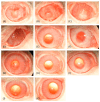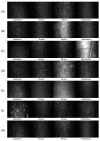Biosynthetic Collagen-Analog Hydrogels Stimulate Endogenous Regrowth of Rabbit Corneas: A Pilot Study
- PMID: 40872735
- PMCID: PMC12390174
- DOI: 10.3390/vetsci12080785
Biosynthetic Collagen-Analog Hydrogels Stimulate Endogenous Regrowth of Rabbit Corneas: A Pilot Study
Abstract
Pro-regenerative corneal implants are being developed to improve corneal healing for companion animals in clinical practice. This pilot study evaluated early corneal tissue and nerve regeneration using biosynthetic collagen-analog hydrogels (CAH) in liquid and solid forms. Their efficacy was compared to each other and to allografts on nine white New Zealand rabbits, divided in three groups of three. Each rabbit cornea underwent keratectomy followed by grafting with either a control allograft cornea, liquid injectable, or solid CAH implant. Corneal healing was assessed over 16 weeks using clinical exams, esthesiometry, in vivo confocal microscopy, and optical coherence tomography. One rabbit per group was euthanized at 3, 10, and 16 weeks for histopathological analysis. Both liquid and solid implants enabled corneal re-epithelialization and regeneration of stromal tissue and corneal nerves. Esthesiometric values indicated faster nerve regeneration in rabbits grafted with biosynthetic implants compared to allografts (p < 0.005). By 16 weeks, regenerated neocorneas achieved transparency comparable to allografts. Solid and liquid CAH implants supported complete corneal tissue and nerve regeneration in the studied rabbits. These results suggest that with further research and development, the current gold standard for corneal transplantation could be replaced by high-performing, easily produced biosynthetic alternatives.
Keywords: allografts; anterior lamellar keratoplasty; collagen analogs; corneal regeneration; corneas; rabbits.
Conflict of interest statement
M.Z.-R., M.-C.R., C.B. and May Griffith (M.G.) are listed as inventors on PCT patent application #CA2024050799—MPC-based copolymers and hydrogels, and uses thereof in regenerative medicine. MC.R is a consultant for Bausch & Lomb, Abbvie, Labtician and EBSCO Health. The other authors declare no conflicts of interest.
Figures







Similar articles
-
Tissue-engineered Bicipital Autologous Tendon Patch Enhances Massive Rotator Cuff Defect Repair in a Rabbit Infraspinatus Tendon Defect Model.Clin Orthop Relat Res. 2024 Dec 1;482(12):2239-2255. doi: 10.1097/CORR.0000000000003218. Epub 2024 Sep 17. Clin Orthop Relat Res. 2024. PMID: 39467146
-
Temporal evolution of the biological response to laser-induced refractive index change (LIRIC) in rabbit corneas.Exp Eye Res. 2021 Jun;207:108579. doi: 10.1016/j.exer.2021.108579. Epub 2021 Apr 20. Exp Eye Res. 2021. PMID: 33864783 Free PMC article.
-
Nocardia Keratitis.2025 Jul 7. In: StatPearls [Internet]. Treasure Island (FL): StatPearls Publishing; 2025 Jan–. 2025 Jul 7. In: StatPearls [Internet]. Treasure Island (FL): StatPearls Publishing; 2025 Jan–. PMID: 31751092 Free Books & Documents.
-
Deep anterior lamellar keratoplasty versus penetrating keratoplasty for treating keratoconus.Cochrane Database Syst Rev. 2014 Jul 22;2014(7):CD009700. doi: 10.1002/14651858.CD009700.pub2. Cochrane Database Syst Rev. 2014. PMID: 25055058 Free PMC article.
-
Interventions for recurrent corneal erosions.Cochrane Database Syst Rev. 2018 Jul 9;7(7):CD001861. doi: 10.1002/14651858.CD001861.pub4. Cochrane Database Syst Rev. 2018. PMID: 29985545 Free PMC article.
References
Grants and funding
LinkOut - more resources
Full Text Sources

